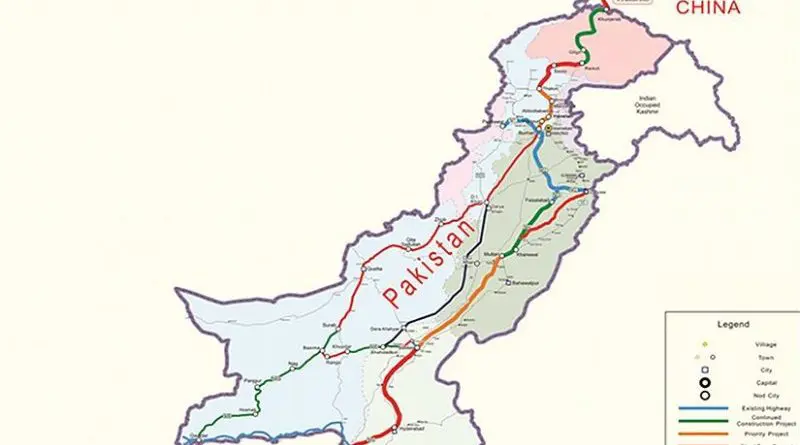China Pakistan Economic Corridor (CPEC): The Long Game Perspective – OpEd
From the very onset, the China Pakistan Economic Corridor (CPEC) has not only become a buzzword on the domestic political scene but sharply divided the domestic political spectrum of Pakistan. The debate surrounding CPEC can be broadly categorized into three types. The CPEC supporters see it as a panacea for most of Pakistan’s problems which is plausible, given its transformative potential. They believe in trickledown economics, put a premium on the centrality of modern infrastructure to economic development, and tend to dismiss all concerns regarding CPEC as attempts to undermine Pakistan-China relations. However, this does not mean that CPEC is not at the crosshair of hostile states, a cursory look at online content reveals how organized disinformation campaigns are targeting this initiative. Detractors do not subscribe to the idea of CPEC as a positive sum. They see terms of the CPEC skewed in favor of China and warn of the Greece and Sri Lanka moment. The third group argues for greater transparency about CPEC projects and advocates equitable share for smaller provinces.
Nonetheless, framing CPEC solely in terms of infrastructure development projects is a reductionist approach. It should be seen from a grand strategic perspective because, in the long run, only a vibrant economy gives real teeth to the foreign policy of any country. It is the economic might of a state that is eventually translated into military power. Since security in international relations is a scarce and costly commodity, states do not allow other states to freeride in terms of security. This is exactly why alliances are considered an inferior arrangement in international relations and a premium is put on developing one’s own military capability. CPEC as an economic stimulus will certainly fulfill this long-term strategic end for Pakistan where its financial and economic autonomy will not hinder its foreign and security policies.
Western media outlets tend to project the functional delays in CPEC projects as an indicator of Pak-China relations. However, the European integration experience which is considered one of the most successful regional integration initiatives was not a smooth ride despite the U.S. patronage and a common Soviet threat as a unifying force. The empty chair crisis of the European Economic Committee (ECC) is an example of how differences on the Common Agriculture Policy (CAP) eventually led to the withdrawal of French representatives from Brussels. The French government’s boycott of European institutions under Charles de Gaulle halted the functioning of the ECC. Therefore, any differences and project delays are purely functional in the context of CPEC and do not necessarily mean that Pak-China relations have nosedived.
Moreover, CPEC is just one part of the six-pronged Belt and Road Initiative (BRI) aimed at improving infrastructure, regional connectivity, and economic development. It should therefore be placed in the gestalt view because reducing it to a standalone project strip it of its actual transformative potential. Infrastructure development underpins regional connectivity and Asian Development Bank (ADB) forecast shows a bleak picture of Asia lagging with an estimated USD 26 trillion gap in infrastructure funding by 2030. BRI is the Chinese response to this gap and its dividends will be shared across the region.
To capitalize on the full potential of CPEC, course correction at the national level is imperative. The divisive and fragmented political spectrum also impedes the pace of projects critically important for uplifting our economy in the long run. As of now, CPEC has been reduced to an instrument of settling scores with political opponents. Electronic media amplifies this negative signaling and intensifies the prevailing acute polarization in society. The culture of unending cliched monologues on the electronic media is pixel poisoning the masses. The modus operandi of these TV programs qualifies for propaganda because most of the content is for public consumption. As the propaganda manuals suggest, intellectuals do not convert and have an aversion to contradictory and repetitive signaling that’s why the focus of electronic media is always on the public. Social media has simply sped up this pixel poisoning, political parties are becoming increasingly dependent on the social media teams using bots and algorithm exploits to push their respective Twitter trends upwards.
Only if parochial interests are not allowed to influence the decision-making vis-à-vis CPEC projects, we will have a more coherent and long-term approach towards this grand plan aimed at overcoming the stopping power of geography. For instance, setting up coal power projects in Sahiwal have higher operational costs when run on imported coal from Indonesia. If the same plants were set up in Karachi, the operational cost would have gone down significantly. Similarly, adhockery is another impediment which keeps haunting us since our independence. Organizational and bureaucratic politics is at the center of this adhockery. The formation of CPEC authority by the former government and the current government signaling its dissolution is just one example of the adhockery that taints our system. Unless a sense of continuity prevails in policies regarding projects of national significance, Pakistan will keep struggling with the unintended consequences of uncertainty at every level. As Mark Twain had quipped that “history does not necessarily repeat itself, but it does rhyme”. In Pakistan’s case, the rhyme is too obvious, it is high time that we get a break from this rhyme and try to write better couplets.
Hussain Muhammad is HEC Indigenous Doctoral Fellow in international relations based in Islamabad. His areas of interests include politics of South Asia and emerging technologies. He tweets as @hussainn91.

